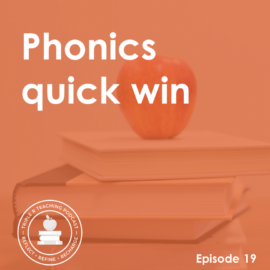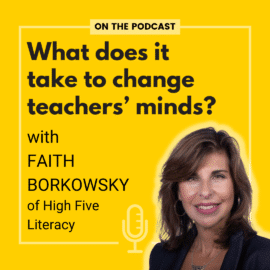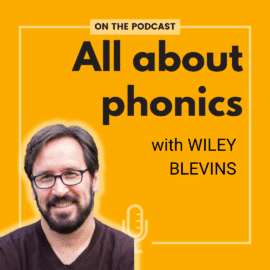TRT Podcast #104: From Balanced Literacy to Decodable Books Author: A conversation with Elise Lovejoy
Like so many of us, Elise Lovejoy began her career as a balanced literacy educator. After throwing herself into research, she created her own decodable books and reading curriculum. Listen to learn more about Express Readers!
Listen to the episode here
Full episode transcript
Today is an interview with Elise Lovejoy, the creator of the Express Readers Decodable Books and Reading Curriculum. We'll get into it right after the intro!
Anna Geiger: Hello everyone! I am very excited today to welcome Elise Lovejoy. She is a former K-2 classroom teacher and is now the creator of the Express Reader Decodable Books and Reading Curriculum. Welcome, Elise!
Elise Lovejoy: Hi! Thank you for having me. I'm so excited.
Anna Geiger: I'm so glad you're here.
What happened was a couple years ago, I think, I had published a blog post with The Ultimate Guide to Decodable Books. Elise emailed me and said, "Hey, I've got some books. Would you be willing to take a look?" So she sent them to me, and I thought they were amazing. I fell in love with them right away. I was able to use some with my little guy before he took off and got out of decodables. I promote them wherever I can because I love them.
Today we get to hear a little bit about Elise's background, how she was, like so many of us, in balanced literacy and what led her into a more structured approach.
Can you give us your background as a teacher and what happened?
Elise Lovejoy: I always knew I wanted to be a teacher, always. I was lining up the neighborhood kids and all my stuffed animals.
Anna Geiger: Yeah, I was the same, in kindergarten.
Elise Lovejoy: It's a calling. I think it really is a calling. So I went to college for it; I went to Boston College. Of course, now it's twenty-some years ago, but I remember specifically learning the names of programs, and then how to teach guided reading. So that was where I started.
My first district I walked into was Fountas & Pinnell. Of course being a twenty-one-year-old, you look to the experts, to your administration, to tell you what you're supposed to do and how to do it right to best help your kids. So I thought it was the law. I thought this is how we did it, and I threw myself into it.
The idea behind it was incredible. I made all these reading spaces. I had beanbags in my class. Kids were just supposed to love books. I think I was shocked when they didn't or when there were so many behaviors in the class around reading time. I thought, "Well, I love reading, and I struggled with it." That's a whole different story, but I eventually loved reading. I was confused. I was really confused.
I was teaching in Boston, and I went to a charter public school, and one of the teachers there was the son of a well known... I don't want to say too much, but he was the son of a well-known foundational skills program. He was big into sounds, phonemes, how the vowels and the consonants play into words, and he was dyslexic.
I started listening to him teaching and thought, "This just makes so much sense to me. I know something's wrong, and he's showing me a different way to do it." And the kids were all learning how to read! Not only were they learning how to read, they had a mastery of it that I hadn't thought was needed to read the way that I could read. So that was incredible.
Then I threw myself into research. When I got into the next school, I immediately grabbed onto phonics. I really wanted to make sure that all my kids had the basics.
What I found was that the materials were dry. It wasn't fun. It wasn't fun the way math was fun. Math was fun! You had toys. You had colorful manipulatives. There were all these games that we played. Reading was "Repeat after me, or this is the sound and then say it."
I thought, "There's got to be a better way to do this."
Of course, I'm sure that there were people already making that and coming up with it, but when you're in a classroom, sometimes the best way to do it is to make it yourself. So I started making it myself. I had phonics books, but they didn't make a lot of sense.
Anna Geiger: I know. I know.
Elise Lovejoy: I thought, "If I have to read one more time about Mel, or the cat and the rat that sat on the mat!" It's so predictable as far as being an adult looking at it.
So I started writing these little books that were based on exactly what the kids were learning in class and only the skills they had been taught.
I loved the wordplay, making sentences out of words that were limited. I would write a list of words and say this is what I should use in this story."
Anna Geiger: I do that, too. It's hard. I think it's hard.
Elise Lovejoy: It is! As I say, it's hard, but I found it really fun, really exciting.
Anna Geiger: That's awesome.
Elise Lovejoy: So I just started making these books. I made these black and white copies, and the kids just ate them up. They loved them. They were reading, and they were excited, and they wanted to know, "When's the next one? What's Dog going to do? What's Cat going to do?" And Bug is in every picture. "Where is he? What's he saying this time?" So I got more and more creative with it.
There's this incredible woman, Marsha Geary. She was an LA principal for a long time. She was out to lunch with my mom, and my mom had a set of my black and white books. She said, "Elise is doing this funny thing in her class. You have to see it because I know you're a teacher."
She said she couldn't finish the rest of lunch because she was just looking through the books. She called me up and she said, "You have to do something with this."
I said, "No, these are for my kids. These are for my students."
She said, "No, you can't keep this to yourself. It's just such a great way to get kids reading!"
Nine years later, here we are.
Anna Geiger: Here we are. This started with your decodable books, but I know you have a reading program, too. How did that come about?
Elise Lovejoy: When I was making the books, I again realized that there needed to be more fun in literacy. I wanted games, and I wanted hands-on materials.
I also struggled with phonics workbooks that had very distracting pages. There was a ton of text on it that the kids couldn't read. It was the directions for the teacher to read. I thought, "There's got to be a better way to make this." I found myself at the photocopier cutting out portions of pages and enlarging them so that the kids were only focusing on what they needed to practice, not on all of this extra text.
So I started making my own workbooks that went along with it. I realized that if I did it in the same structure as the books, then I could use these two together. It was really very much a teacher piecing things together based on the knowledge. I really threw myself into curriculum.
That's when I left the classroom because I was supporting the teachers. I was doing a lot of research and a lot of reading and really trying to dot my i's and cross my t's and make sure I was doing it right. Children deserve our best, and it really meant something to me to do it right.
Actually, this is a story nobody knows. Not that I haven't told it, but I just don't tell it often. I went to EdReports with the first version of our program, and I failed. It's out there now, my failure is somewhere out in the public.
When I was talking to the people at EdReports, I said, "I'm just beside myself!" I think they thought immediately that I was beside myself because I was going to lose money or something along those lines, but I said, "I failed these classes!"
Now I hadn't because the people that were using it were incredible educators. They were fitting and putting in the pieces that I was missing, and they were making sure that their kids were getting everything they needed.
But in my head, I had this very important job, and I hadn't done it to the best of my ability.
So I told them I'm going to replace it out of pocket. My husband, thank goodness he believes in this the way I do, because out of pocket from our family's money, I rewrote it, and I gave it to every school that had bought it.
We went yellow on EdReports, if you know what that means. It's kind of like "partially meets." The pieces that we didn't have at the time were a systematic phonemic awareness program and a sight word curriculum, some way to introduce those.
Anna Geiger: That's interesting.
Elise Lovejoy: Yeah. It wasn't a piece that I had focused on a lot. So we're going back to EdReports actually this spring. We're in the queue to be reviewed again, and I think we're going green. So I'm really excited.
Anna Geiger: Well, that's cool. Now, you've been in this for a long time. So many people I talk to, it was really 2020 or 2019 that they came around. Maybe you can talk to us about what you were reading and studying back then, this is over ten years ago.
Elise Lovejoy: I read a lot of research. I clung on to the Journal of Literacy with researchers and looking at how big the base was, the stuff that's kind of boring, but I started to find it really interesting.
I have to say, I think that the reason that it took us as long as it did to get here where this is so public and urgent - obviously, it's always been urgent that children need to learn how to read - but the research is really hard to read. It's not made for a teacher.
Anna Geiger: I know, it's not. It's not, and not for tired teachers either.
Elise Lovejoy: No. Teachers have enough on their plate. You're exhausted at the end of the day, and it is mentally exhausting reading some of the research. The people who are creating it are brilliant, but it is not translated for our classrooms.
I think that enough people have started trying to do that. When somebody asks me, "Oh, what do you want to say about your program or your books?" and to be honest, I want to support all the people that are doing what I'm doing, too. I want more of us. I think that we have to create things that teachers can use easily because their job is already so difficult.
Anna Geiger: I can just talk to those who are listening who have not seen Express Readers. They are pretty large, square books, and hand-illustrated, which they have a very special charm, and there is this little bug on every page to find, which is fun.
But when you open the page, the text is on the left in big Comic Sans font and lots of spacing. Then the full color picture is on the right. So it is a very user-friendly, reader-friendly I should say, book.
They're also very sturdy, so these are quality books. They have fun pictures and sturdy pages.
Can you tell us a little bit about your reading program?
Elise Lovejoy: We are a TK, because I'm in California where transitional kindergarten is big. So we're TK through second grade. TK is really just the first in a two-year kindergarten. It's like they've split it and allowed younger children to be a part of it. It's a mix of pre-K and K basically. But it's TK through second grade, so it's all the foundational skills in reading, because I know my role.
People say, "Oh, are you going to go into third through fifth?"
I say, "Nope, not right now!"
My world is this piece where we're really teaching kids how to read and making sure that they can access everything in third grade and above.
We have a great phonemic awareness program now. We call it the Daily Do's. The kids are jumping, they're dancing, they're cutting, and they're using all kinds of imagination in order to do it. Ours has a visual piece to it. I know that the research that has come out has said we really should be tying phonics to it early on.
To be honest, I did that before I had read anything about that because in a rational sense, especially out here in California, when we've got so many English as a second language learners, the more times we can connect that and show it, I think that the better chance kids have of making that connection. And why not show it? You just don't require them to know it yet. So we have a visual piece that goes with ours.
We also use a lot of pictures because, again, English is a second language for many. Why not be hearing words and seeing a picture of it so you can acquire more vocabulary? So that's been really fun. I actually went out to New York a little while ago and got to see the teachers doing the Daily Do's-
Anna Geiger: Oh, how exciting!
Elise Lovejoy: ... and it was really exciting! I heard from a professor at NYU. She said, "Oh, this is the Daily Do's." She said, "Yeah, my student teachers talk about it all the time."
Anna Geiger: Oh, that's so great. That's so great.
Elise Lovejoy: We cover all the foundational skills in reading, so basically how to teach reading and how to comprehend what you're reading because I think that that immediately ties in. It shouldn't just be this disconnect between phonics and the process.
But it did center around our books; it started with that. It started with kids being able to access the meaning behind, "Why are we reading? Why are we doing this work? Let's have something funny at the end of it."
Anna Geiger: What's next for Express Readers?
Elise Lovejoy: Oh, well, first, it'll be the EdReports.
We are a family-based, kind of home-grown company. As I've told my family and those close to me, I really want to do this right. I want to go slow. I'm not looking to make this monster of a company. I want to make sure that teachers are always involved and always on staff and having more voices be heard. We need to make sure that we're reading all of the research before we develop things, and so I don't want to rush things out.
Hopefully, the next thing for us is to write more decodables, to be a supportive and quality company and resource for teachers to go to.
Anna Geiger: Well, I hope that more people will check you out after listening to this episode!
Elise Lovejoy: Thank you!
Anna Geiger: I will definitely link to that in the show notes. Anything else you want to share before we end?
Elise Lovejoy: I would really like for teachers to know how important decodable books are, mine or anyone else's. It's so important for a child to see their success and to use what they're learning in real time. It's so important, and I'm so appreciative that you gave me the chance to talk about it.
Anna Geiger: Well, thank you so much. Thank you so much for listening. To get links to check out Elise's books, including free samples and free printable books, go ahead and head to the show notes, themeasuredmom.com/episode104. Talk to you next time!
Sign up to receive email updates
Enter your name and email address below and I'll send you periodic updates about the podcast.








Leave a Comment